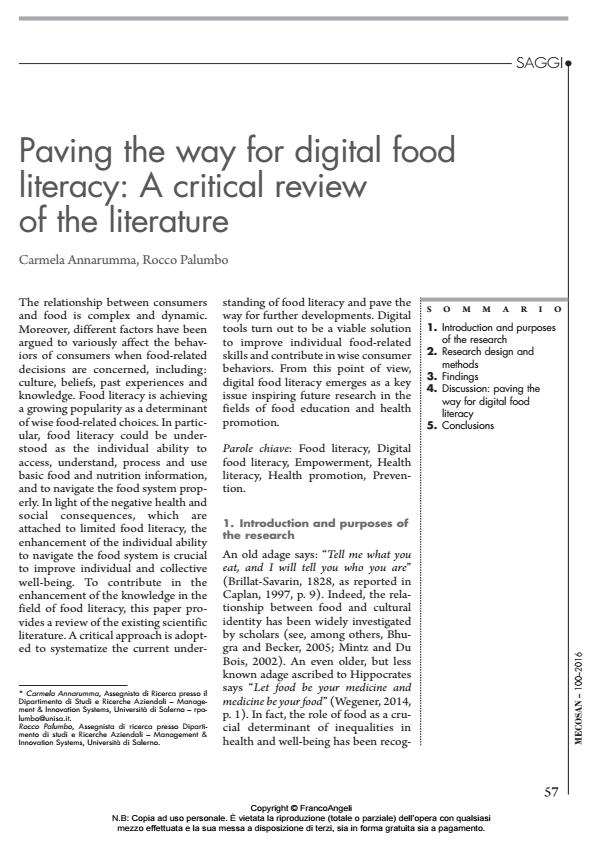Paving the way for digital food literacy: A critical review of the literature
Journal title MECOSAN
Author/s Carmela Annarumma, Rocco Palumbo
Publishing Year 2017 Issue 2016/100
Language English Pages 19 P. 57-75 File size 23801 KB
DOI 10.3280/MESA2016-100004
DOI is like a bar code for intellectual property: to have more infomation
click here
Below, you can see the article first page
If you want to buy this article in PDF format, you can do it, following the instructions to buy download credits

FrancoAngeli is member of Publishers International Linking Association, Inc (PILA), a not-for-profit association which run the CrossRef service enabling links to and from online scholarly content.
The relationship between consumers and food is complex and dynamic. Moreover, different factors have been argued to variously affect the behaviors of consumers when food-related decisions are concerned, including: culture, beliefs, past experiences and knowledge. Food literacy is achieving a growing popularity as a determinant of wise food-related choices. In particular, food literacy could be understood as the individual ability to access, understand, process and use basic food and nutrition information, and to navigate the food system properly. In light of the negative health and social consequences, which are attached to limited food literacy, the enhancement of the individual ability to navigate the food system is crucial to improve individual and collective well-being. To contribute in the enhancement of the knowledge in the field of food literacy, this paper provides a review of the existing scientific literature. A critical approach is adopted to systematize the current understanding of food literacy and pave the way for further developments. Digital tools turn out to be a viable solution to improve individual food-related skills and contribute in wise consumer behaviors. From this point of view, digital food literacy emerges as a key issue inspiring future research in the fields of food education and health promotion.
Keywords: Food literacy, Digital food literacy, Empowerment, Health literacy, Health promotion, Prevention.
- Food-related knowledge transmission among Syrian refugees in Germany Lubana Al-Sayed, Claudia Bieling, in International Journal of Migration, Health and Social Care /2025 pp.244
DOI: 10.1108/IJMHSC-07-2024-0076 - Una misurazione "euristica" dell'alfabetizzazione alimentare: alcuni spunti esplorativi Carmela Annarumma, Rocco Palumbo, Ersilia Troiano, Stefania Vezzosi, in MECOSAN 102/2018 pp.61
DOI: 10.3280/MESA2017-102004 - Le comportement alimentaire des étudiants de l’Université de Yaoundé I, Cameroun : entre la littératie alimentaire, la littératie en santé et l'e-littératie alimentaire André Wamba, Ange Maïn-Ndeiang Laoungang, Gustave Soh, in Global Health Promotion /2024 pp.122
DOI: 10.1177/17579759231206379
Carmela Annarumma, Rocco Palumbo, Paving the way for digital food literacy: A critical review of the literature in "MECOSAN" 100/2016, pp 57-75, DOI: 10.3280/MESA2016-100004